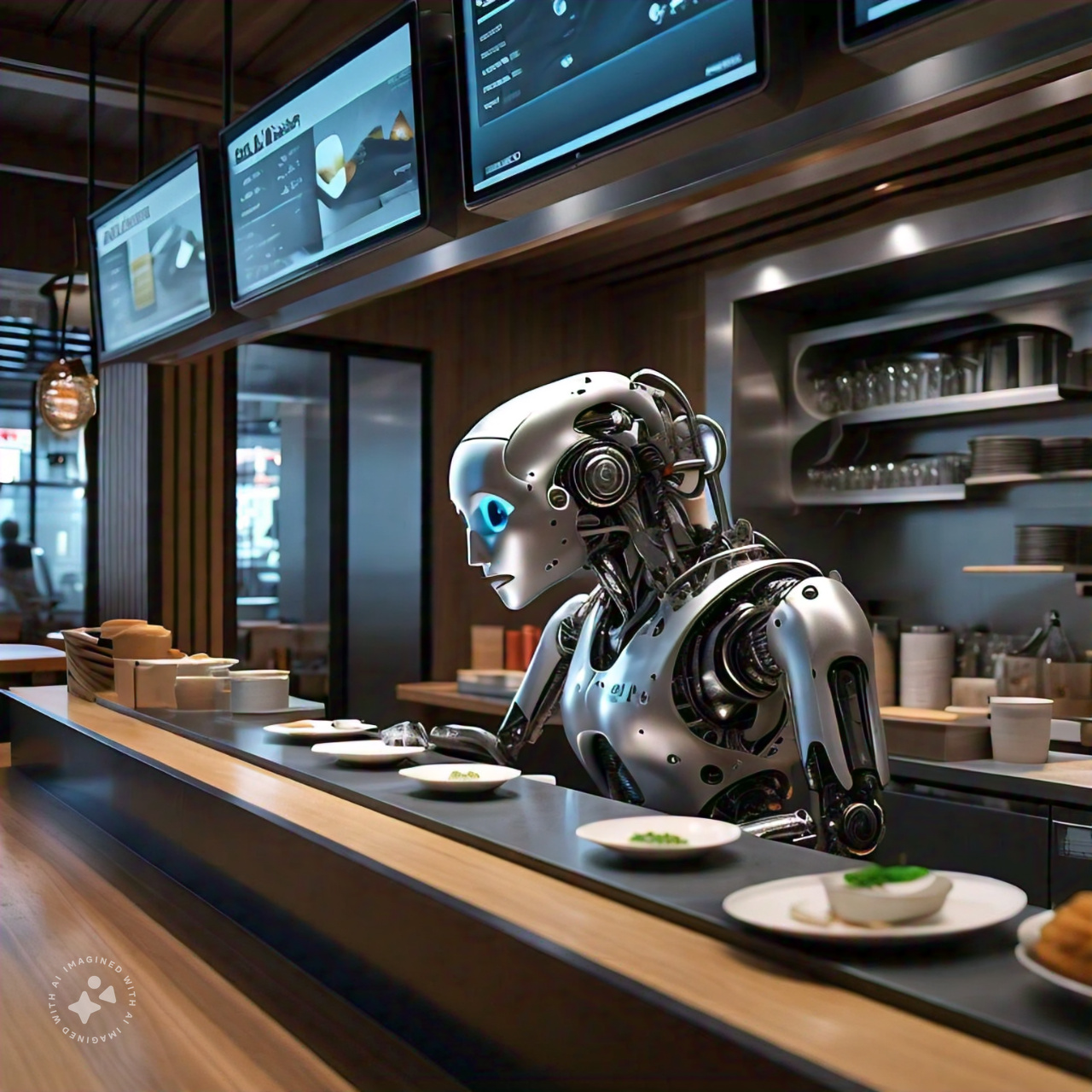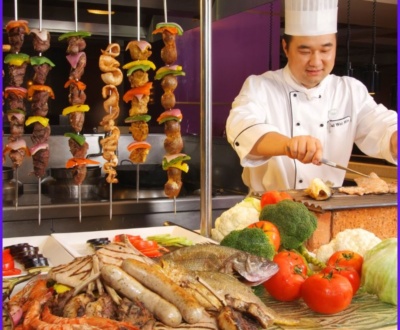Understanding Benefits of AI for restaurant businesses: A Simple Guide
Artificial Intelligence, or AI, is changing the way restaurants operate. From ordering food to managing kitchen tasks, AI is making things easier and faster. Let’s explore how Benefits of AI for restaurant businesses and what it means for customers and staff.
What is AI?
AI refers to computer systems that can perform tasks that usually require human intelligence. This includes things like understanding language, recognizing patterns, and making decisions. In restaurants, AI helps improve service, enhance customer experiences, and increase efficiency.
How is AI Used in Restaurants?
1. Online Ordering and Delivery
Many restaurants now use AI for online ordering. When you visit a restaurant’s website or app, AI helps recommend meals based on your past orders and preferences. This makes it easier for customers to choose what they want. Some delivery services also use AI to find the fastest routes for drivers, ensuring your food arrives quickly.
A. AI-Powered Chatbots for Ordering
AI chatbots and voice assistants are often integrated into restaurant websites or apps to take customer orders. These bots can:
- Handle multiple orders simultaneously without human intervention.
- Understand natural language through NLP (Natural Language Processing), making it easier for customers to place orders via text or voice.
- Personalize recommendations based on a customer’s order history and preferences.
- Answer FAQs regarding menus, delivery time, promotions, and more.
B. Recommendation Engines
AI uses customer data and algorithms to suggest meals or promotions based on:
- Past orders: Recommending similar dishes or items frequently purchased together.
- Customer preferences: Offering suggestions based on dietary preferences (vegetarian, gluten-free, etc.).
- Popular items: Suggesting trending dishes in the restaurant.
- Weather conditions or time of day: For example, promoting hot drinks on cold days or lighter meals at lunch.
C. Automated Order Processing
AI streamlines the backend processes by:
- Automatically sending orders from the app or website to the kitchen, optimizing communication.
- Minimizing errors through automated input, reducing miscommunication between the customer and the kitchen staff.
- Assigning delivery drivers based on location and availability using algorithms to reduce delivery times.
D. Predictive Analytics for Demand Forecasting
AI helps restaurants predict demand patterns based on:
- Historical data: Understanding when peak hours are likely to occur or which days are busier.
- External factors: Including weather, holidays, and local events that might impact the number of orders.
- Inventory management: AI systems forecast ingredient usage, reducing food waste and ensuring that restaurants don’t run out of key items.
E. Dynamic Pricing & Promotions
AI can dynamically adjust pricing based on demand or offer real-time promotions. For example:
- Discounts during off-peak hours: Encouraging customers to order when the kitchen is less busy.
- Surge pricing: Increasing prices during high-demand periods, similar to ride-sharing apps.
- Targeted promotions: Personalized promotions based on customer history, such as offering a discount on a favorite dish.
F. AI-Powered Delivery Route Optimization
AI is used to optimize delivery routes, improving efficiency by:
- Finding the fastest route based on real-time traffic data.
- Grouping multiple deliveries in the same area to maximize efficiency.
- Tracking drivers in real-time, allowing customers to see their order status and estimated delivery time.
G. Voice Ordering
AI systems like Google Assistant, Alexa, or custom-built restaurant AI assistants allow customers to order food via voice commands. This simplifies the ordering process for those who prefer not to type or navigate apps.
H. Robotic and Autonomous Deliveries
AI-powered robots and drones are increasingly used to deliver food, especially in urban areas. These systems use AI for:
- Navigating the environment: Recognizing obstacles, traffic, and pedestrians.
- Enhancing security: Ensuring that food is delivered securely and to the right recipient.
- Reducing delivery times and costs in the long run by minimizing human labor.
I. AI-Enhanced Customer Service
AI helps manage customer service by:
- Analyzing feedback: AI systems can analyze customer reviews or feedback from social media and review platforms to identify areas of improvement.
- Responding to issues quickly: AI chatbots can handle complaints or queries about missing items, delayed deliveries, etc.
- Creating loyalty programs: AI can analyze customer behavior and design personalized rewards or loyalty programs based on their preferences.
J. Order Prediction and Auto-Reordering
AI can predict when a customer may be ready to reorder based on their past behavior. For example:
- Auto-reordering options: Offering to repeat a previous order with just one click.
- Time-based predictions: Noticing that a customer typically orders every Friday night and sending them a notification to remind them.
K. Improved User Interfaces
AI helps improve the design of online ordering platforms by analyzing:
- User interactions: Finding common points of friction, such as abandoned carts or difficulties navigating menus.
- Personalized interfaces: Adjusting the interface layout based on individual preferences, such as displaying vegan options first for a known vegan customer.
l. Fraud Detection and Prevention
AI detects fraudulent activity by:
- Monitoring payment behavior: Flagging unusual or potentially fraudulent orders.
- Identifying patterns: Spotting patterns of fake orders or repeated chargebacks.
- Securing customer data: Using AI to enhance encryption and data protection methods.
Examples in Use:
- Domino’s Pizza uses AI in its “Domino’s Anyware” platform, allowing customers to order via text, smart speakers, smart TVs, and social media.
- Starbucks implemented an AI-driven recommendation system that suggests drinks based on weather, time of day, and past orders.
- Uber Eats and DoorDash use AI to optimize delivery routes, minimize delivery times, and make restaurant recommendations to users.
By implementing AI in online order and delivery, restaurants improve customer satisfaction, reduce costs, streamline operations, and increase revenue. AI ensures a seamless, personalized, and efficient experience for both customers and restaurants alike.
2. Chatbots for Customer Service
Chatbots are AI programs that can chat with customers online. They can answer questions about the menu, take reservations, or handle complaints. This allows restaurants to provide 24/7 customer support without needing a human staff member to be available all the time.
. Enhanced Customer Support through AI Chatbots
- 24/7 Availability: AI-powered chatbots can be available round-the-clock, handling customer queries about menu items, hours of operation, locations, or special offers, even when human staff are unavailable.
- Natural Language Understanding: AI chatbots use natural language processing (NLP) to understand customer questions, respond more naturally, and provide accurate, conversational responses. This makes customer interactions more personalized and engaging.
- Reservation Management: AI chatbots can handle reservations, manage seating times, and provide updates on table availability, reducing waiting times and the need for human staff intervention.
- Order Taking: Customers can place orders through AI chatbots that are integrated with the restaurant’s ordering system. The chatbot can suggest popular dishes or combos based on customer preferences or previous orders.
- Multilingual Support: AI can cater to diverse customers by supporting multiple languages, making it easier for international customers to navigate menus and place orders.
3. Inventory Management
AI can help restaurants keep track of their ingredients. It can predict how much food will be needed based on past sales data and seasonal trends. This helps reduce waste and ensures that restaurants have the right amount of food on hand.Inventory management in restaurants is crucial for several reasons. It helps streamline operations, reduce waste, and optimize profits. Here’s a breakdown of the key benefits of inventory management in a restaurant setting:
a. Cost Control and Profit Maximization
- Accurate Costing: By keeping track of ingredients and supplies, restaurants can better understand their food costs. This allows for precise pricing of menu items and helps avoid over-portioning, reducing waste and improving margins.
- Waste Reduction: Managing inventory ensures that ingredients are used before they spoil, reducing food wastage. You can track which items are nearing expiration and plan menu specials around them.
- Preventing Over-ordering: Good inventory management prevents over-purchasing, reducing the risk of excess stock that can spoil before use.
b. Improved Cash Flow
- Optimizing Purchases: Effective inventory management helps restaurants know how much to order and when to order it. This prevents tying up cash in excess stock and allows the business to maintain steady cash flow.
- Better Supplier Relations: Regular monitoring of stock levels ensures that you order supplies in a timely manner, reducing the risk of last-minute orders which can be more expensive or lead to shortages.
c. Enhanced Menu Planning and Flexibility
- Consistency in Menu Offerings: When inventory is well-managed, restaurants can avoid running out of popular ingredients, ensuring that all menu items are available as advertised.
- Menu Adjustments Based on Stock: If certain items are in surplus, restaurants can create specials or promotions to encourage sales, avoiding waste and improving customer satisfaction.
d. Increased Operational Efficiency
- Time Savings: Automated or organized inventory systems save staff time. Rather than manual stocktaking, digital systems can track stock levels in real time and even generate automatic orders when supplies run low.
- Better Workflow: With an organized inventory system, staff can easily locate ingredients and supplies, leading to faster preparation times and smoother kitchen operations.
e. Reduction in Theft and Fraud
- Tracking Inventory Shrinkage: Proper inventory management can detect theft or fraud by tracking what goes missing. Any discrepancies between what was bought and what remains can alert management to potential issues.
- Improved Accountability: When staff know that inventory is closely monitored, they may be less likely to engage in misuse or theft of resources.
f. Compliance and Health Standards
- Ensuring Freshness and Safety: Regular inventory checks help ensure food safety standards are met. By rotating stock and using a first-in, first-out (FIFO) approach, restaurants can ensure that older ingredients are used first, preventing the use of expired or unsafe food.
- Meeting Regulations: Many jurisdictions have regulations about food storage and safety. A good inventory system helps maintain proper storage and rotation, reducing the risk of violations and fines.
g. Improved Forecasting and Planning
- Sales Data Integration: Restaurants can use inventory data to forecast future demand more accurately, leading to better decision-making. For example, seasonal trends or special events can affect the demand for certain items, and inventory management systems can track these patterns.
- Supplier Negotiation: By understanding usage patterns, restaurants can negotiate better terms with suppliers, securing discounts for bulk purchases or more favorable delivery schedules.
h. Customer Satisfaction
- Avoiding Stockouts: Nothing is more frustrating for a customer than ordering an item only to be told it’s unavailable. Efficient inventory management ensures that popular items are always in stock, improving the customer experience.
- Consistent Quality: By maintaining control over the ingredients and their freshness, restaurants can consistently provide high-quality dishes, boosting customer satisfaction and loyalty.
In summary, inventory management in restaurants helps in cost control, waste reduction, operational efficiency, and overall profitability. It enables better forecasting, improves cash flow, and ensures food safety, contributing to a smoother and more successful restaurant operation.
4. Personalized Dining Experience
Some restaurants use AI to create a more personalized experience. For example, if you frequently order vegetarian dishes, AI can suggest similar options when you visit next. This makes dining more enjoyable and tailored to your tastes.how improve ai. Personalized Dining Experience
To improve AI for a personalized dining experience, you can focus on several areas that enhance customer satisfaction, increase operational efficiency, and provide unique experiences tailored to individual preferences. Here are key strategies to achieve this
a. Advanced Customer Profiling
- Use Machine Learning (ML) Models: Develop ML algorithms that learn and adapt to customer preferences over time based on their order history, feedback, and behavior. The models can suggest personalized dishes based on dietary preferences, food allergies, or favorite ingredients.
- Natural Language Processing (NLP): Implement NLP to analyze customer reviews, feedback, or social media mentions to refine customer profiles and better understand their tastes.
- Predictive Analytics: Use predictive analytics to forecast customer needs and suggest seasonal or special dishes based on their past orders.
b. Tailored Recommendations
- Personalized Menus: Provide custom menus tailored to individual preferences, showing dishes based on factors like dietary restrictions (e.g., vegetarian, gluten-free), favorite cuisines, or previous orders.
- AI-Powered Chatbots: Deploy conversational AI chatbots to interact with customers, offering recommendations based on their current mood, previous meals, or even the weather (e.g., suggesting hot soups on cold days).
c. Integrating IoT and Sensors for Contextual Dining
- Smart Table Technology: Integrate IoT sensors at dining tables that recognize returning customers via mobile apps or facial recognition. This tech can trigger personalized greetings, display custom menus, and suggest favorite or recommended dishes based on their previous visits.
- Geolocation and Real-Time Context: AI can use geolocation data to provide context-aware dining suggestions. For instance, if a customer is near a restaurant they like, the AI can push personalized deals or suggest nearby restaurants with similar menus.
d. Nutritional Guidance and Health-Based Personalization
- Nutritional Data Integration: Incorporate AI systems that provide personalized nutritional insights. For example, fitness or health data from wearable devices could sync with the dining platform, allowing for real-time recommendations based on the user’s current fitness goals (e.g., high-protein meals after a workout).
- Health-Based Meal Suggestions: AI can analyze a customer’s medical conditions (e.g., diabetes, hypertension) and recommend healthier alternatives or appropriate meal portions.
e. Enhanced Dining Ambiance with AI
- Custom Ambiance: Smart lighting and sound systems can adjust the ambiance based on customer preferences or special occasions. If a customer often dines in a romantic setting, the restaurant could automatically lower the lights and play soft music.
- Personalized Augmented Reality (AR): Use AR for interactive dining experiences, such as projecting visual stories about the origin of a meal, special recipes, or interactive virtual displays about the ingredients and nutrition of the dish in real-time.
f. Optimizing Customer Engagement and Loyalty
- AI-Powered Loyalty Programs: Enhance loyalty programs with AI that predicts which offers will most likely attract a specific customer, encouraging repeat visits. Personalized deals or early access to new menu items could be provided based on loyalty levels and preferences.
- Dynamic Pricing: AI can offer personalized discounts or meal bundles based on individual preferences, purchase frequency, or even specific customer profiles to maximize satisfaction and retention.
g. Efficient Order Management and Customization
- Seamless Custom Orders: Use AI to streamline custom orders by remembering detailed preferences, such as ingredient substitutions or preferred cooking styles (e.g., rare steak). This helps to reduce errors in custom orders and speed up the process.
- Voice Ordering Systems: Implement AI voice recognition technology that allows customers to place orders via voice commands, where the system recognizes their preferences for a seamless ordering experience.
h. Personalized Delivery and Convenience
- AI-Enhanced Delivery Preferences: Personalize the delivery experience by using AI to optimize delivery times and routes. The system could recognize when a customer typically orders dinner and recommend optimal delivery times based on their schedule.
- Automated Re-ordering: For regular customers, AI can offer automated reordering for favorite dishes, either as a suggestion or even as a scheduled repeat order.
i. Customer Sentiment Analysis and Feedback Loop
- Real-Time Feedback Systems: Implement AI that instantly analyzes customer feedback and adjusts their dining experience in real-time. For example, if feedback indicates a certain dish is consistently rated poorly by a customer, the system can stop recommending that dish and suggest alternatives.
- Sentiment Analysis of Reviews: AI can analyze online reviews and social media comments, helping restaurants adjust their services or menus to align with customer expectations, while also tailoring recommendations for specific customer profiles.
j. Data Security and Privacy
- Data Protection: Ensure that the AI system complies with data privacy regulations, such as GDPR or CCPA, and offers customers control over what personal data they want to share. Transparency about how their data is being used for personalization is crucial for trust and long-term customer relationships.
- Anonymized Data Usage: Use anonymized data to personalize without compromising individual privacy. This can help balance personalization with a respect for customer data concerns.
Example Use Case
Imagine a customer with lactose intolerance regularly visiting a restaurant. The AI, learning from past orders and feedback, could automatically present a lactose-free menu each time they visit or order online. If the weather is cold, it might suggest a warm lactose-free soup. At the same time, the AI chatbot can inquire about the customer’s mood or occasion, offering tailored dining options like a low-carb dessert for those tracking their calorie intake.
By focusing on these strategies, restaurants can use AI to elevate the dining experience, offering personalized, enjoyable, and efficient services that keep customers coming back for more.
5. Smart Kitchen Equipment
AI is also found in kitchen appliances. Smart ovens and fryers can adjust cooking times and temperatures automatically, ensuring that food is cooked perfectly every time. This helps chefs focus on creating delicious dishes instead of worrying about the cooking process.
Improving AI for smart kitchen equipment can greatly enhance the user experience by making kitchen tasks more efficient, convenient, and enjoyable. Below are some key ways to improve AI in this context, from hardware integration to advanced features:
a. Advanced Sensor Integration
- Real-Time Cooking Monitoring: Equip kitchen appliances with sensors that can monitor food conditions (e.g., temperature, moisture levels, and doneness) in real-time. AI can analyze this data to adjust cooking times and temperatures dynamically.
- Nutritional Analysis: Integrate AI with sensors that can analyze food composition (calories, nutrients, etc.) and make suggestions for healthier options based on personal dietary preferences or restrictions.
b. Machine Learning for Personalization
- Recipe Customization: AI can learn from a user’s preferences (spiciness, favorite ingredients, cooking times) and adjust recipes accordingly. Over time, the system would optimize meal recommendations based on past behaviors and dietary needs.
- Voice Recognition and Context Understanding: AI voice assistants (like Alexa or Google Assistant) can be improved by understanding kitchen-specific contexts, like recommending substitutions if an ingredient is missing or providing step-by-step instructions based on real-time user progress.
c. Predictive Maintenance
- Self-Diagnosis: AI can monitor the performance of kitchen appliances and predict when maintenance is required (e.g., filters need replacing, or motors are wearing out). This would help reduce downtime and avoid costly repairs.
- Energy Efficiency Optimization: AI can track and optimize power usage in appliances like ovens, refrigerators, or dishwashers, reducing energy consumption when it’s not necessary (e.g., automatically turning off when a cooking task is complete).
d. Enhanced Interconnectivity (IoT)
- Cross-Device Coordination: AI can improve smart kitchens by ensuring devices work in sync. For instance, your oven could automatically start preheating when a recipe step requires it, or your fridge could communicate with your phone to suggest recipes based on available ingredients.
- Inventory Management: With AI and sensors, smart refrigerators or pantry systems can track food usage and notify users when something is running low. Some systems can even automate grocery shopping by connecting with online delivery services.
e. Enhanced Food Recognition and Guidance
- AI Vision and Image Recognition: Cameras and image recognition technology can help the AI recognize ingredients, measure portions, and even identify food quality. This is useful for tasks like identifying overripe produce or recommending ways to use leftovers.
- Cooking Process Guidance: Use computer vision to follow the user’s actions, offering real-time feedback (e.g., detecting if onions are chopped too coarsely or checking if a dish has browned correctly).
f. Natural Language Processing (NLP) and Conversational AI
- Improved Voice Commands: Make AI assistants better at understanding complex cooking-related queries. For example, allowing users to ask nuanced questions like, “Can I substitute almond flour for regular flour in this recipe?” or “How do I prevent my sauce from curdling?” with detailed, contextual responses.
- Multi-Language Support: For global users, the AI could understand and provide instructions in multiple languages or even help translate international recipes into the user’s native language.
g. AI-Driven Meal Planning and Nutrition
- Meal Planning Based on Preferences/Health Goals: AI could use health data (e.g., weight, fitness level, medical history) to offer personalized meal plans. It can also factor in seasonal ingredients, budget preferences, and even sustainable food choices to recommend recipes.
- Cooking Assistance for Allergies/Dietary Restrictions: AI could flag potential allergens in recipes or recommend modifications that adhere to specific diets, such as keto, vegan, or low-sodium.
h. User-Friendly Interfaces and Experiences
- Augmented Reality (AR) Assistance: AR interfaces could allow users to visualize steps or adjustments in cooking. For example, an AR-enabled display could overlay instructions directly onto the kitchen counter or cookware, guiding the user through a recipe visually.
- Gamification of Cooking: Introduce interactive, gamified elements to make cooking more engaging. AI could track a user’s progress, give feedback on technique, and reward improvements or completed challenges.
i. Data-Driven Feedback Loops
- User Feedback Integration: After using a recipe or appliance, users could rate their experience. AI could use this feedback to improve future suggestions, fine-tune instructions, or offer tips based on how previous users have interacted with the recipe.
- Data Sharing Across Appliances: AI can create a cohesive ecosystem by allowing appliances to share cooking data. For example, if a user sets their coffee machine to make coffee every morning at 8 AM, the system could sync the toaster to start simultaneously.
j. Sustainability and Waste Reduction
- Reducing Food Waste: AI could track expiration dates and offer meal suggestions to prevent food spoilage. It could also track which ingredients are often discarded and suggest portion adjustments or alternatives to reduce waste.
- Sustainable Energy Use: AI-driven kitchen appliances can be designed to minimize energy consumption and maximize efficiency, whether through scheduling low-power operations during off-peak hours or optimizing cooking methods to conserve energy.
Future Technologies to Consider
- Robotic Assistance: AI-driven robotic arms could assist with simple kitchen tasks like stirring, chopping, or even plating food.
- 3D Food Printing: For novelty or health-focused purposes, AI-driven 3D food printers could create precise meals or dishes, factoring in nutrients, textures, and flavors as desired by the user
6. Feedback and Reviews
AI can analyze customer feedback from reviews and social media. By understanding what customers like or dislike, restaurants can make necessary changes to improve their services and menus.
Benefits of AI for restaurant businesses
- Efficiency: AI can automate many tasks, saving time for staff and reducing wait times for customers.
- Cost Savings: By optimizing inventory and reducing waste, restaurants can save money.
- Better Customer Experience: Personalized recommendations and quick service can enhance the dining experience.
- Improved Decision Making: AI can provide insights based on data, helping restaurant owners make informed decisions.

“Transform Your Dining Experience: Discover How AI Elevates Restaurant Efficiency, Personalization, and Flavor Innovation!”
More from our blog
See all postsRecent Posts
- Understanding What is SEO in Digital Marketing : A Comprehensive Guide December 30, 2024
- Benefits of Digital Menu Board(step by step guide for restaurant) October 12, 2024
- Why SEO is important for Restaurant? October 12, 2024








Pingback: Benefits of Digital Menu Board(step by step guide for restaurant) - Dghackers